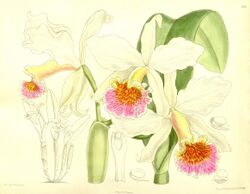Biology:Cattleya rex
| Cattleya rex | |
|---|---|

| |
| Cattleya rex flowers and leaf. | |
| Scientific classification | |
| Kingdom: | Plantae |
| Clade: | Tracheophytes |
| Clade: | Angiosperms |
| Clade: | Monocots |
| Order: | Asparagales |
| Family: | Orchidaceae |
| Subfamily: | Epidendroideae |
| Genus: | Cattleya |
| Subgenus: | Cattleya subg. Cattleya |
| Section: | Cattleya sect. Cattleya |
| Species: | C. rex
|
| Binomial name | |
| Cattleya rex O'Brien
| |
Cattleya rex is a species of epiphytic orchid of showy white flowers, native to montane forests in Peru and Bolivia.
Description
Epiphytic herb with cylindric or spindle-shaped pseudobulbs, up to 35 cm. high, with one leaf at the top.[1][2] Leaf oblong or elliptic-oblong, obtuse, light green, up to 35 cm. long and up to 6 cm. wide, coriaceous.[1][2] Inflorescence up to 20.3 cm. high, with 3 to 6 (or 10) flowers.[1][3] Flowers large and showy, up to 17 cm wide, with sepals and petals being cream-colored or ivory white, except the lip or labellum, which is colored with yellow, rose and red.[1][2][4][5][3] Sepals narrowly elliptic; petals ovate, elliptic or rhomboid; lip folded to form a tube, with very wavy front margin.[1][2][4][3] Pollinia 4, with curved appendages.[2]

Taxonomy
James O'Brien described the species for the first time in 1890 from a live flowering plant collected in the area of Moyobamba, San Martín by Mr. Bungeroth and cultivated at L'Horticulture International, Brussels, by Mr. L. Linden.[1][2][4][5] That was the first known flowering plant outside the native habitat of C. rex.[2][4]
Distribution and habitat
Cattleya rex is known from a few localities in the regions of San Martin and Puno in Peru and the department of La Paz in Bolivia.[1][6][7][8] It occurs in montane forests and low montane seasonally dry forests at 800–2500 m, growing on tree branches.[6][7][8]
Ecology
In its native habitat, flowering occurs between December and March.[6]
Conservation
Cattleya rex has been assigned an endangered conservation status in 1997 by the IUCN.[9] Previously believed to be a Peruvian endemic, in 2013 a new locality was reported in Bolivia, thus increasing the area of extension for the species.[8]
Cultivation
Cattleya rex requires a temperate climate (16 °C at night and 28 °C during the day) and good ventilation (a dark and enclosed environment will attract fungi or bacterial diseases).[10][3]
This species does not tolerate dryness for long periods, so watering must be done regularly and should be reduced in frequency during winter.[10][3] However, the growing medium (cork slabs, baskets or pots) must have good drainage, so the roots can dry properly after watering or root rot may appear.[10][3]
Light requirements are high but not direct sunlight. Shade is needed during summer and brightest days of other seasons (especially if leaves turn yellow).[10][3]
Humidity must be between 50-70%, it can be achieved with the help of misters or humidifiers.[10][3]
References
- ↑ 1.0 1.1 1.2 1.3 1.4 1.5 1.6 Schweinfurth, C., "Orchidaceae, Orchids of Peru", Fieldiana, Botany 30(3): 535
- ↑ 2.0 2.1 2.2 2.3 2.4 2.5 2.6 Rolfe, R. (1911). "Cattleya rex". Curtis's Botanical Magazine. 4 (Royal Botanic Gardens, Kew) 7 (77): Tab. 8377. ISSN 0011-4073. https://www.biodiversitylibrary.org/page/442071.
- ↑ 3.0 3.1 3.2 3.3 3.4 3.5 3.6 3.7 Withner, C. (1988). The Cattleyas and Their Relatives. 1: The Cattleyas. Timber Press. pp. 29–30. ISBN 9780881920994.
- ↑ 4.0 4.1 4.2 4.3 O'Brien, J. (1890). "Cattleya rex". The Gardeners' Chronicle. 3 8: 684. http://www.epidendra.org/taxones/Cattleya/Cattleya%20rex/cattleya_rex_prot.pdf.
- ↑ 5.0 5.1 "The Showy Cattleya, Queen of the Orchids - BEGINNERS' HANDBOOK - XV". http://www.aos.org/orchids/additional-resources/cattleya-queen-of-the-orchids.aspx.
- ↑ 6.0 6.1 6.2 Cavero, Moisés; Collantes, Benjamín; Patroni, César (in es). Orquídeas del Perú (1a parte). CDC - UNALM. pp. 17.
- ↑ 7.0 7.1 Dodson, C.; Bennett, D. (1989). Orchids of Peru. Missouri Botanical Garden.
- ↑ 8.0 8.1 8.2 Fuentes, A. (2013). "Nuevos registros de la Región Madidi para la flora de plantas vasculares de Bolivia" (in es). Kempffiana 9 (1): 3–20. ISSN 1991-4652.
- ↑ Walter, Kerry S.; Gillett, Harriet J. (1998) (in en). 1997 IUCN Red List of Threatened Plants. IUCN. ISBN 9782831703282. https://archive.org/details/1997iucnredlisto97walt.
- ↑ 10.0 10.1 10.2 10.3 10.4 "Cattleya rex - Cattleya Source" (in en). http://cattleya.wikidot.com/cattleya-rex.
External links
Wikidata ☰ Q5054152 entry
 |


